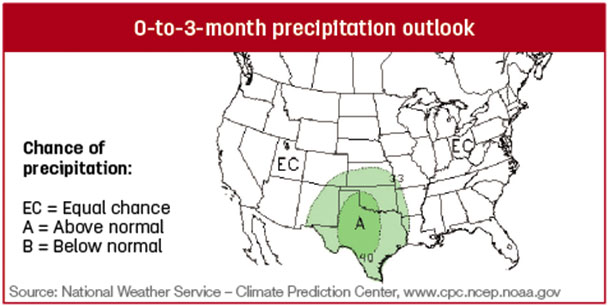Hay samples should be collected and sent to a forage lab for analysis; this is critical to develop an economic feeding plan. A good practice is to use a hay probe to sample approximately 10 percent of the bales from each cutting; these samples can then be combined to produce a composite. Samples should be taken from bales randomly throughout the stack for each field or cutting.
Forage type (native or introduced) and geographic location in Kansas, Oklahoma and Texas will determine how long forages can be stockpiled and the best way to manage and utilize them. Introduced forages should only be stockpiled for about the last 60 days before frost to maintain forage quality.
In lower-rainfall areas, native range can be stockpiled at any point during the growing season. However, when a large amount of forage is grown early in the spring, it is often lower in quality when winter arrives; in this situation, it may be beneficial to test the stockpiled forage to ensure selection of the best supplement.

At a minimum, forage samples should be tested for both crude protein and total digestible nutrients; total digestible nutrients are a measurement of the energy content of a feed. Before submitting samples for analysis, visit with a beef cattle nutritionist for lab recommendations and to determine what tests should be conducted.
Dairy One Forage Lab in Ithaca, New York, and Cumberland Valley Analytical Services in Hagerstown, Maryland, are two labs many beef and dairy cattle nutritionists utilize.
Supplements should be priced based on their cost per unit of protein, energy or both. For example, if crude protein is the primary nutrient needed, multiply the quantity of feed by the percent crude protein in the feed. Then divide the price of the feed by the pounds of protein in the sack.
50-pound sack of cubes x 38 percent CP = 19 pounds of crude protein per sack
$9.50 ÷ 19 pounds of crude protein = 50 cents per pound of protein
For 20 percent cubes that cost $8 per sack, the price per pound of protein would be 80 cents. This same calculation can be done when pricing energy supplements or any other nutrient. ![]()

-
Jason Banta
- Associate Professor and Extension Beef Cattle Specialist
- Texas A&M University
- Email Jason Banta







